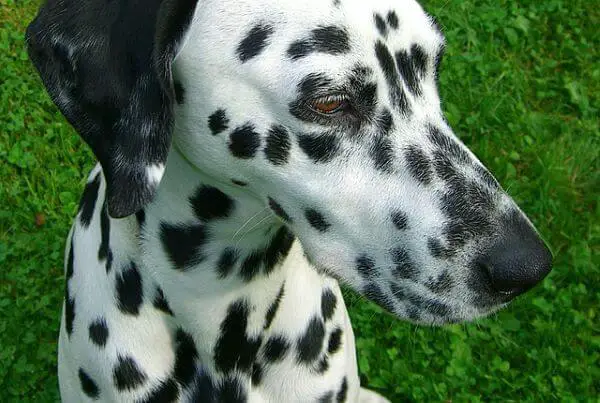
How many puppies can a Dalmatian have? Litter sizes are usually between, 8 to 10 puppies on average. However some have less, or even up to as many as 15.
Dalmatian Puppies
To understand the Dalmatian's reproduction process, explore the breeding and gestation period. Both of these sub-sections play a crucial role in the Dalmatian's reproductive journey.Breeding Time
Mating and Reproduction of Dalmatians is affected by age, physical health, and female's reproductive cycle. Ideal breeding time is between two and five years. Estrus cycle is three weeks, peak fertility is between day 11 and day 15.
Not all Dalmatians are equal for reproduction. Some may have medical issues or genetic factors, leading to early pregnancies and weak puppies. Proper nutrition and healthcare should be provided to both male and female dogs. Artificial insemination or genetic testing may be done before selecting a mate.
Dog lovers should not breed their pet without professional help as it can be dangerous. Consult with vets and reputable breeders for advice. This will help maintain the quality and longevity of the canine breed. Patience is a must for 63 days of pregnancy!
Gestation Period
Time to Bear Dalmatians!
Gestation for Dalmatians is around 63 days. In this period, the female experiences change in appetite, sickness and sleepiness. On average, they give birth to 8-10 puppies.
Proper attention is needed during pregnancy. It includes proper nutrition, exercise and regular vet check-ups. Vaccine records should also be kept in order before mating. This will help avoid certain diseases during breeding.
Famous stories with Dalmatians often feature them carrying their cute puppies. In actuality, they are known for having multiple litters in their life, and being amazing mothers.
It's clear that Dalmatians understand the meaning of 'large family'!
Litter Size of Dalmatian
To understand the litter size of Dalmatians, you need to look at the two sub-sections: average litter size and factors affecting litter size. While the average litter size of Dalmatians is relatively consistent, there are some factors that can impact litter size. These sub-sections will provide you the solution to understand the litter size of Dalmatians.Average Litter Size
Dalmatians - popular pups with a penchant for picky litter size!
Their litters vary based on several factors: environment, nutrition, age, breeding method, and genetics. Though one can control nutrition and environment, the final litter size is often unpredictable. Plus, not all Dalmatians will produce the same number of puppies every time they mate. Take Pongo and Perdita from Disney's '101 Dalmatians' for example - they birthed an amazing 15 puppies in their first litter! This story serves as an inspiration, but also a warning of potential health risks associated with large litters. It looks like Dalmatians are just like us, trying to get the most out of their resources!
Factors Affecting Litter Size
The number of pups in Dalmatians is influenced by several factors. These include genetics, age, diet, environment, and the health of both parents. To understand how these play a role, refer to the table.
| Factor | Effect on Litter Size |
|---|---|
| Genetics | Influence large litters |
| Age | Younger and older dogs may have smaller litters |
| Diet & Environment | Promote larger litter sizes |
| Health of Parents | Can lead to smaller litters |
| Responsible Breeding Practices | Increase chances of healthy puppies |
Vet check-ups, proper pre- and post-natal care, and quality food with essential nutrients are important. With these measures, you can foster healthy pup growth and improve the breed's welfare. Raising Dalmatian puppies is a huge responsibility - but the puppy love you get in return is worth it!
Care for Dalmatian Puppies
To care for your Dalmatian puppies with a holistic approach, it is important to consider their food and nutrition, vaccinations, socialization, and training. Each of these sub-sections plays a crucial role in ensuring your puppies grow up healthy, happy, and well-behaved. Let's explore each of these areas in more detail to give your Dalmatian puppies the best possible start in life.Food and Nutrition
For optimal care of young Dalmatian canines, it is essential to feed them a balanced and nutritious diet. A table should include columns for types of food, quantity, frequency and supplements needed for puppies. High-quality puppy kibble, chicken or fish-based proteins and fiber are usually included.
Liver, kidneys and other purine-rich foods should be avoided, as they can lead to kidney stones formation. Offer smaller meals more often, and keep water available.
Vitamins and minerals can supplement their diet, based on age requirements. Keeping a consistent mealtime routine will help with healthy eating habits. Offer your Dalmatian immunity, like you do with hand washing and stocking up on toilet paper.
Vaccinations
Immunization is key for your Dalmatian pup's health. Vaccines protect them from deadly diseases and help them stay healthy. DHPP and Rabies shots must be given during the pup's 12-16 weeks.
Schedule a visit to the vet clinic to get the pup vaccinated. The vet will examine them before giving the shots. Keep vaccination records, so it's easy to know when booster doses or health assessments are due.
Socializing the pup is also important. They'll meet veterinarians and other pet owners and this will help develop their mental state.
Vaccinating pups continues until they're 16-20 weeks old. After that, adult dogs need yearly vaccines, depending on their lifestyle and contact with contagious animals. Parvovirus is one of the leading causes of puppy death due to inadequate vaccination schedules. Make sure to teach your Dalmatian puppy manners, too!
Socialization and Training
Prioritizing socialization and training for Dalmatian pups is essential for their proper development. Introducing them to different experiences and stimuli early on can help prevent fear aggression and shyness.
Positive reinforcement, such as treats and praise, can encourage good behavior. Consistent repetition of commands is important to build their understanding.
Gradually working up levels of difficulty, such as adding distractions or requiring longer periods of concentration, will help build their resistance to distractions.
One person shared how they had trouble socializing their Dalmatian pup because of a lack of exposure during the critical early stage. This resulted in barking, hiding and fear aggression. They had to seek professional help, but wished they had prioritized socialization from the start. Managing large litters takes puppy mayhem to a whole new level!
Management of Large Litters
To manage large litters of Dalmatian puppies, potential health risks and steps to manage the situation should be taken into consideration. This requires understanding the sub-sections - potential health risks for Dalmatians with large litters, and steps to manage large litters - as solutions to the challenges that come with caring for a large litter.Potential Health Risks for Dalmatians with Large Litters
Dalmatians can suffer from health risks when giving birth to large litters. These include eclampsia, hypocalcemia and uterine rupture. These issues can result in severe health problems for both mother and litter, and even be life-threatening. It is essential to have a plan for managing large litters to avert these risks.
To reduce the risk, owners must provide proper nutrition during pregnancy and lactation. They must also track the dog's health during pregnancy and seek vet help promptly when necessary. Correct birthing procedures can also lessen the chances of complications.
It is advised to monitor litter size through careful breeding practices. This includes selecting suitable mates, age-appropriate breeding intervals, and limiting litter size based on the mother's size and age.
The immense popularity of Disney's "101 Dalmatians" in 1961 led to overbreeding and bad breeding practices, which caused major health issues in dogs with large litters. By understanding these potential health risks and taking proactive measures to prevent them, breeders can guarantee that their dogs stay healthy and happy. Managing a large litter calls for expertise in crowd control and time management - just like a kindergarten teacher on speed!
Steps to Manage Large Litters
When it comes to breeders managing large litters:
- Recognize how many offspring is 'too much.'
- Come up with a standard number and focus on postnatal management.
- Create a clean, comfortable and disinfected birthing environment.
- Ensure appropriate bedding and nesting material is provided.
- Feeding schedules should prioritize nutrients rather than frequency.
- Opt for diets rich in protein and fat that support optimal growth.
- Carefully observe all aspects of maternal health during the period of lactation.
- Seek advice from a vet if necessary.
Additionally, spend time researching coping skills specific to the species you're working with before the birth of another litter. And remember - take photos or measurements to keep track of each little one's progress. With effort and care, everyone will thrive! Especially when it comes to Dalmatian litters - it's all paws on deck!
Conclusion: Understanding Dalmatian Reproduction and Litter Size
Dalmatian Reproduction and Litter Size can be quite fascinating. Usually, 8 to 10 puppies is the average litter size. But, some Dalmatians could have less, or even up to 15.
Ethical breeding practices are a must. Overbreeding can cause health issues and put strain on the mother dog. Responsible breeders will use breed standards and genetic testing for healthy puppies.
Exercise, nutrition and a stress-free pregnancy are key for raising a healthy litter. By taking these factors into account, Dalmatians can produce pups with excellent physical attributes and gentle temperaments.
One client shared their experience raising six Dalmatian puppies. They found it rewarding but financially demanding. They warned future breeders to be aware of potential costs before getting into breeding.
